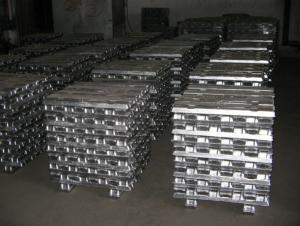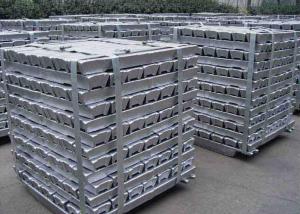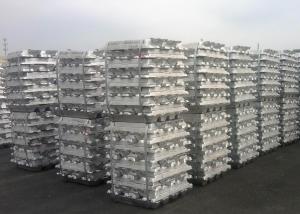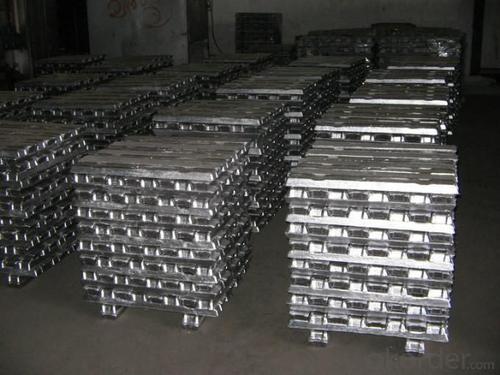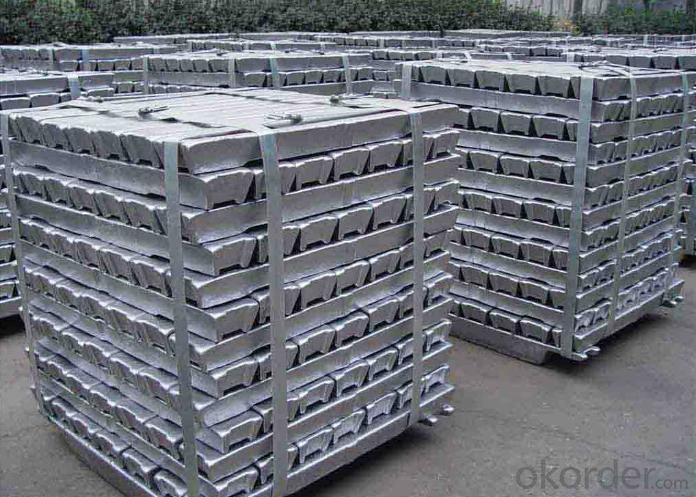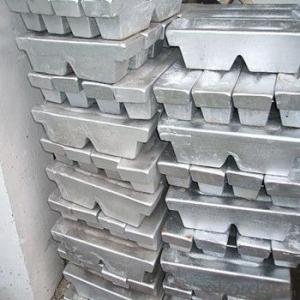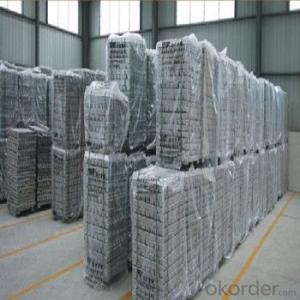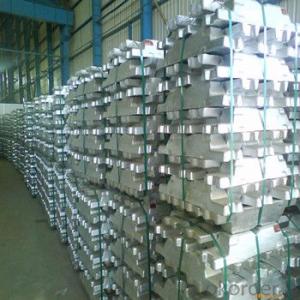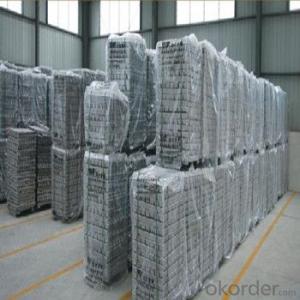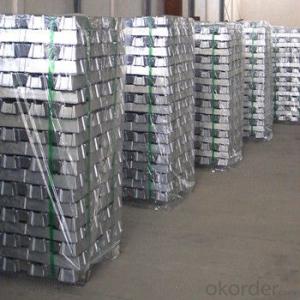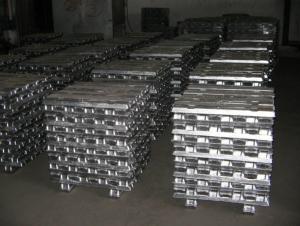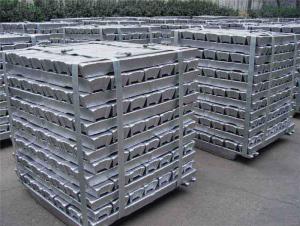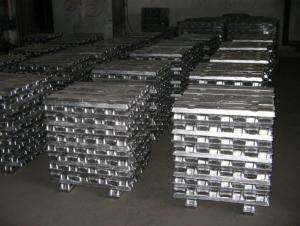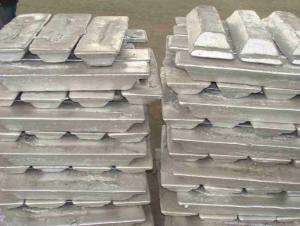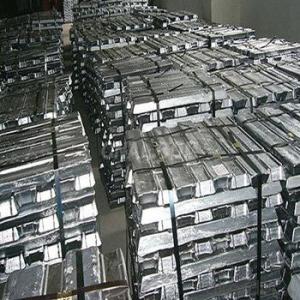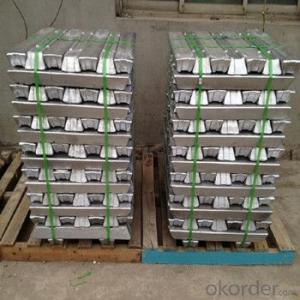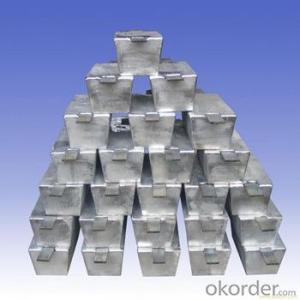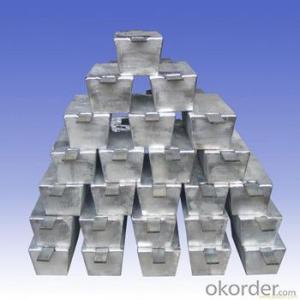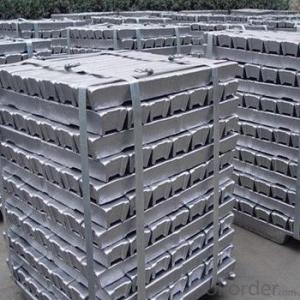Aluminum Ingots AA1050
- Loading Port:
- Shanghai
- Payment Terms:
- TT or LC
- Min Order Qty:
- 20 Tons m.t.
- Supply Capability:
- 1000 Sets Per Month m.t./month
OKorder Service Pledge
Quality Product, Order Online Tracking, Timely Delivery
OKorder Financial Service
Credit Rating, Credit Services, Credit Purchasing
You Might Also Like
1. Specifications of Aluminum Ingots AA1050
| Product Name | Aluminum Ingot |
| Chemical Composition | Al |
| Weight | 20/25kg |
| Al (Min) | 99%-99.9% |
| Appearance | silvery white |
| Advantages | easy control and operation, fast melting |
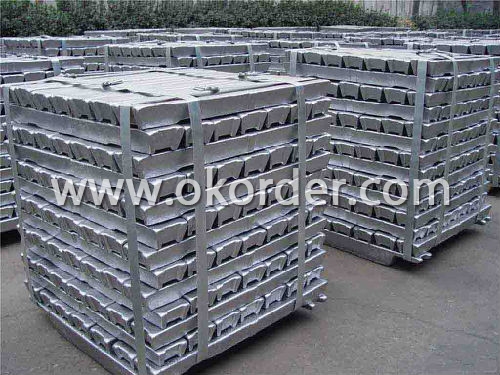
2. Usage/Application of Aluminum Ingots AA1050
A. mainly used for melting ingot
B. discontinuous melting with scrap
3.Packaging & Delivery of Aluminum Ingots AA1050
About 25Kg /Ingot, Packed in wooden case, Net weight 1000Kg/ Case, or as customer's requirements.
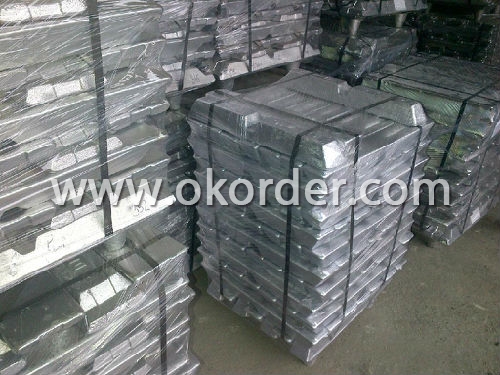
- Q: The difference between electrolytic aluminium, alumina and aluminium ingot
- Two, the production process is relatively speaking, the process of alumina production is more complex, the production of a ton of aluminum ingots require about two tons of alumina, the product must be expensive to produce aluminum ingots.
- Q: What's the difference between aluminium ingot A380 and ADC12?
- Two kinds of material are different, mainly reflected in the silicon content above, A380 is the number of ADC12 is made, day number.
- Q: Difference between ingots and alumina
- Our daily industrial material called aluminum ingots, it is made of alumina cryolite by electrolysis aluminum is produced. The standard containing 99.7% aluminum ingots, registered in the London market is it.
- Q: How much does it cost to process the aluminum ingots into T5-6063 models? Now, what about costing the aluminum ingot or the aluminum bar?
- 6063 is the alloy brand, T5 by the high temperature forming process cooling, and then the artificial aging stateThe utility model is suitable for artificial aging products after being cooled by the high temperature forming process without being cold processed (which can be straightened and straightened without affecting the mechanical performance limit)
- Q: A ton of scrap melting into pure aluminum ingot to sell how many pure profit 11 tons of aluminum melts much pure aluminum removal processing fees and all other costs of artificial coal freight
- The first question to you "good quality aluminum material scrap can to 2% off will take a closer look at the difference! The profit depends on the price of scrap wanted! If the price is higher, it will lose! Generally do this not eight hundred profit than do backing! So your eyes are better. "When you see the goods, you should know how many times you can make them."! The general profit is a good product to pull the ocean but people often do is disabled!
- Q: What are the different casting methods used for aluminum ingots?
- There are various casting methods commonly utilized in the production of aluminum ingots. These methods encompass: 1. Utilizing Permanent Mold Casting: This technique involves the use of an iron or steel permanent mold to shape the molten aluminum into ingots. The mold is preheated and coated with a release agent to prevent sticking. The molten metal is then poured into the mold, left to solidify, and subsequently, the mold is opened to extract the ingot. 2. Employing Continuous Casting: This method necessitates pouring the molten aluminum into a water-cooled mold that possesses a continuous cavity. As the metal solidifies, it is constantly drawn out of the mold, resulting in a continuous strand of aluminum ingots. This approach is frequently employed for the production of substantial quantities of ingots with consistent shapes. 3. Implementing Sand Casting: Sand casting is a widely employed technique for casting aluminum ingots. A sand pattern of the desired ingot shape is created, and then the mold is formed by packing sand around the pattern. The molten aluminum is poured into the mold and allowed to cool and solidify. Once solid, the sand mold is broken apart to reveal the ingot. 4. Utilizing Die Casting: Die casting is a method commonly used to produce small to medium-sized aluminum ingots with intricate details. In this process, a steel mold, known as a die, is employed. The molten aluminum is forced into the die at high pressure and rapidly cooled to solidify. The die is then opened, and the ingot is ejected. 5. Employing Centrifugal Casting: In this method, the molten aluminum is poured into a rotating mold. The centrifugal force causes the metal to spread out and solidify against the mold walls, resulting in a cylindrical ingot. This approach is particularly beneficial for manufacturing hollow or tubular ingots. Each casting method possesses its own set of advantages and disadvantages, and the selection of the method depends on factors such as the desired ingot shape, size, quantity, and specific application requirements.
- Q: How are aluminum ingots used in the production of consumer goods?
- Due to their versatility and desirable properties, aluminum ingots have become widely used in the manufacturing of consumer goods. These ingots undergo a process of melting and transformation into different forms, such as sheets, bars, or coils, to suit various manufacturing processes. One popular application of aluminum ingots is in the production of packaging materials. Aluminum foils and cans, which are lightweight, corrosion-resistant, and malleable, are ideal for preserving food and beverages. The ingots are rolled into thin sheets, which are then used to create these packaging materials. The automotive industry is another major user of aluminum ingots. Aluminum's low density and high strength-to-weight ratio make it an excellent choice for manufacturing car parts, including engine components, body panels, and wheels. By utilizing aluminum ingots, automakers can produce lighter vehicles, leading to improved fuel efficiency and better performance. Moreover, aluminum ingots find extensive usage in the construction sector. These ingots are often extruded into profiles used for windows, doors, and curtain walls. Aluminum's corrosion resistance and ability to withstand extreme weather conditions make it a popular choice for building materials. Furthermore, aluminum ingots are employed in the production of consumer electronics. The lightweight characteristics of aluminum make it an ideal material for manufacturing laptops, tablets, and smartphones, where weight reduction is crucial for portability. The ingots are processed into casings, frames, and other components for these electronic devices. In summary, aluminum ingots play a crucial role in manufacturing a wide range of consumer goods. Their versatility, lightweight nature, and corrosion resistance make them suitable for various applications in industries such as packaging, automotive, construction, and electronics.
- Q: Can aluminum ingots be customized for specific applications?
- Certainly, specific applications can have customized aluminum ingots. Aluminum, a remarkably adaptable metal, can be effortlessly shaped to fulfill diverse needs. Typically, the customization procedure includes combining the aluminum with other elements to amplify qualities like strength, hardness, resistance to corrosion, and thermal conductivity. Furthermore, the ingots can undergo various heat treatment methods such as annealing, quenching, and tempering to further adjust their properties. Consequently, aluminum ingots that are precisely designed for particular applications can be manufactured, encompassing a wide range from automotive parts and aerospace components to construction materials and consumer products.
- Q: What are the properties of aluminum ingots?
- Aluminum ingots possess a range of distinct properties that render them highly valuable across numerous industries. Primarily, aluminum ingots demonstrate exceptional lightness due to their low density in comparison to other metals. This characteristic proves ideal for sectors such as aerospace and automotive where weight reduction is crucial. Furthermore, aluminum ingots showcase excellent resistance to corrosion, rendering them suitable for environments where exposure to moisture, chemicals, or harsh weather conditions is likely. This resistance is a result of the formation of a thin, protective oxide layer on the surface of the ingot, effectively preventing further oxidation and deterioration. Another notable property of aluminum ingots is their high thermal conductivity, allowing for efficient heat transfer. This attribute proves particularly advantageous in heat exchange systems, where the ingots facilitate the transfer of thermal energy. Additionally, aluminum ingots also exhibit excellent electrical conductivity, making them well-suited for applications within the electrical and electronics industries. Moreover, aluminum ingots possess a high strength-to-weight ratio, providing strength while remaining lightweight. This property enables the construction of structures that require both durability and strength without compromising on weight. Additionally, aluminum ingots are easily recyclable, maintaining their properties even after undergoing multiple recycling processes, making them an environmentally friendly choice. In summary, the properties of aluminum ingots, including their lightness, corrosion resistance, thermal and electrical conductivity, high strength-to-weight ratio, and recyclability, contribute to their widespread utilization across various industries. These industries range from transportation and construction to packaging and consumer goods.
- Q: Can aluminum ingots be used in the production of jewelry?
- Indeed, the application of aluminum ingots in the production of jewelry is possible. Aluminum, being a versatile metal, lends itself easily to the molding and shaping required for various jewelry designs. With its lightweight nature, it ensures a comfortable wearing experience, while its inherent silver-like appearance can be further magnified through diverse surface finishes, including polishing or anodizing. Moreover, its hypoallergenic properties render it an appropriate choice for those individuals with sensitive skin. Although aluminum may not possess the same value as precious metals like gold or silver, it presents a more economical alternative for crafting jewelry and can be combined with other materials to yield distinctive and fashionable pieces.
We are a well-known enterprise specializing in the production and sales of aluminum sheets and coils.
Since the establishment of us, we have been devoted to setting up a good CIS and completely implementing ISO9001 quality management system.
1. Manufacturer Overview
| Location | Henan,China |
| Year Established | 1993 |
| Annual Output Value | Above US$200 Million |
| Main Markets | Mid East;Eastern Europe;North America |
| Company Certifications | ISO 9001:2000;ISO 14001:2004;OHSAS 18001 |
2. Manufacturer Certificates
| a) Certification Name | |
| Range | |
| Reference | |
| Validity Period |
3. Manufacturer Capability
| a) Trade Capacity | |
| Nearest Port | Shanghai |
| Export Percentage | 30%-50% |
| No.of Employees in Trade Department | 21-50 People |
| Language Spoken: | English;Chinese |
| b) Factory Information | |
| Factory Size: | Above 100,000 square meters |
| No. of Production Lines | Above 10 |
| Contract Manufacturing | OEM Service Offered;Design Service Offered |
| Product Price Range | Average |
Send your message to us
Aluminum Ingots AA1050
- Loading Port:
- Shanghai
- Payment Terms:
- TT or LC
- Min Order Qty:
- 20 Tons m.t.
- Supply Capability:
- 1000 Sets Per Month m.t./month
OKorder Service Pledge
Quality Product, Order Online Tracking, Timely Delivery
OKorder Financial Service
Credit Rating, Credit Services, Credit Purchasing
Similar products
Hot products
Hot Searches
Related keywords
